Abstract
New possible causes and unexplored aspects of the electroretinogram were evaluated in a case of vitamin A deficiency secondary to surgical therapy for morbid obesity. The Naka-Rushton equation, applied to the scotopic b-wave, demonstrated the quantal catch reduction caused by the loss of rhodopsin in the outer segment of photoreceptors. Study of the Fourier analysis of the photopic 20-Hz response suggested a primary involvement of the external retinal layers, with an indirect alteration of the inner layer. The electroretinogram oscillatory potentials showed alterations explained by the involvement of their generators related to the primary photoreceptor lesion.
Similar content being viewed by others
References
Deitel MB. Surgery for morbidly obese patient. Philadelphia: Lea & Febiger, 1989.
Shils ME, Young VR. Modern nutrition in health and disease. Philadelphia: Lea & Febiger, 1988.
Bornschein H, Vukovich V. Das Elektroretinogramm bei Mengelhemeralopia. Graefes Arch Ophthalmol 1953; 153: 484–7.
Dowling JE, Wald G. Vitamin A deficiency and night blindness. Proc Natl Acad Sci 1958; 44: 648–61.
Dowling JE, Wald G. The biological function of vitamin A acid. Proc Natl Acad Sci 1960; 46: 587–608.
Noell WK. ERG in experimental toxicology.In: The Clinical Value of Electroretinography, Proc. XX, ISCERG symposium Ghent, 1966, J. Francois ed., Basel, Karger 1968, 290–99.
Auerback E. The value of different components for clinical electroretinography.In: Francois J, ed. The clinical value of electroretinography. Basel: S Karger. 1968: 162–72.
Genest A. Vitamin A and the electroretinogram in humans.In: Francois J, ed. The clinical value of electroretinography. Basel, S Karger, 1968: 21–4.
Gombos GM, Hormblass A, Vendeland J. Ocular manifestation of vitamin A deficiency. Ann Ophthalmol 1970; 2: 680–4.
Bors F, Folls P. Reversal of the complication of self-induced vitamin A deficiency Br J Ophthalmol 1971; 55: 210–4.
Naka K, Rushton WAH. S-potentials from luminosity units in the retina of fish (cyprinidont). J Physiol 1966; 185: 587–99.
Fulton AB, Rushton WAK. Rod ERG of the mudpuppy: effect of dim red backgrounds. Vision Res 1978; 18: 785–92.
Anastasi M, Brai M, Lauricella M, Geracitano R. Methodological aspects of the application of the Naka-Rushton equation to clinical electroretinogram. Ophthalmic Res 1993; 25: 145–56.
Wachmeister L. Basic researches and clinical aspects of the oscillatory potentials of the electroretinogram. Doc Ophthalmol 1987; 66: 187–94.
Anastasi M, Lauricella M, Ponte F. Photopic ERG components in retinitis pigmentosa. Acta Ophthalmol 1992; 70: 187–93.
Anastasi M, Lauricella M, Barbera F. ERG fotopico nelle affezioni vascolari della retina: analisi delle componenti. Boll Ocul 1992; 71(suppl 1): 43–8.
Ponte F, Anastasi M, Lauricella M. Retinitis pigmentosa and inner retina. Functional study by means of oscillatory potentials of the electroretinogram. Doc Ophthalmol 1989; 73: 337–43.
Rogers EL, Douglas W, Russel RM, Bushman L, Hubbard TB, Iber FL. Deficiency of fat soluble vitamins after jejunoileal by-pass surgery. Am J Ophthalmol 1989; 89: 776–9.
Pearlman I, Barzilai D, tamar H, Schramek A. Night vision in a case of vitamin A deficiency due to malabsorption. Br J Ophthalmol 1983; 67: 37–42.
Hood DC, Birch DG. A computational model of the amplitude and implicit time of the b-wave of the human ERG. Vis Neurosci 1992; 8: 107–26.
Wald G. Molecular basis of visual excitation. Science 1968; 162: 230.
Bridges CDB. The rhodopsin-porphyropsin visual system.In: Dartnall HFA, ed. Handbook of sensory physiology, New York, Springer Verlag. 1972; 71/1: 417.
Curtis L, Baker JR, Hess F. Linear and non linear components of human electroretinogram. J Neurophysiol 1984; 51: 951–67.
Hess FR, Baker CI, Zrenner E, Schwarzer J. Differences between electroretinogram of cat and primate. J Neurophysiol 1986; 56: 747–68.
Porciatti V, Falsini N, Fadda A, Bolzani R. Steady-state analysis of the focal ERG to pattern and flicker. Relationship between ERG components and retinal pathology. Clin Vision Sci 1989; 4: 323–32.
Author information
Authors and Affiliations
Rights and permissions
About this article
Cite this article
Anastasi, M., Lauricella, M. & Ponte, F. Surgical therapy for obesity can induce a vitamin A deficiency syndrome. Doc Ophthalmol 90, 143–155 (1995). https://doi.org/10.1007/BF01203334
Accepted:
Issue Date:
DOI: https://doi.org/10.1007/BF01203334




